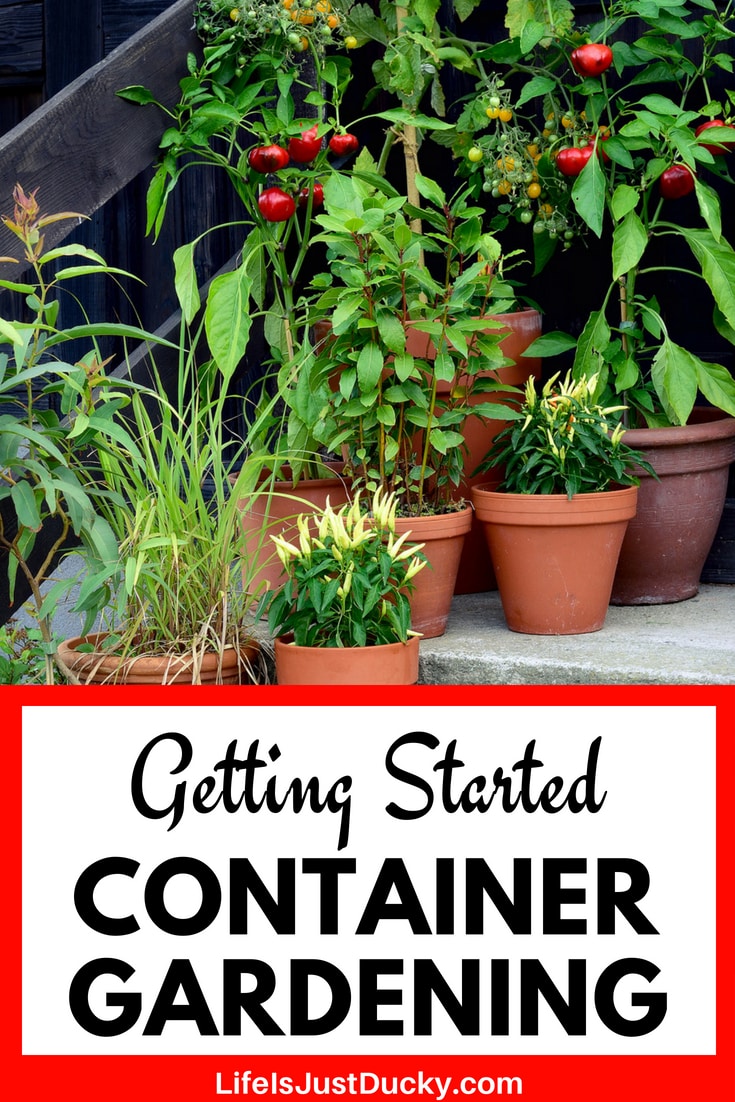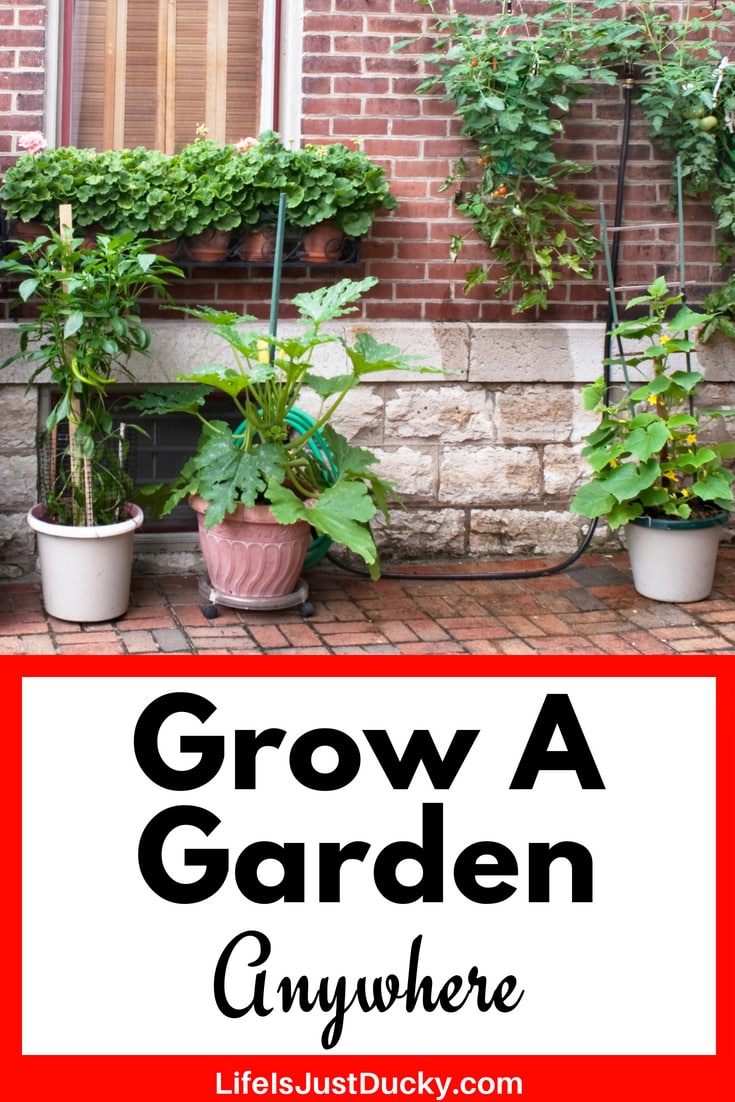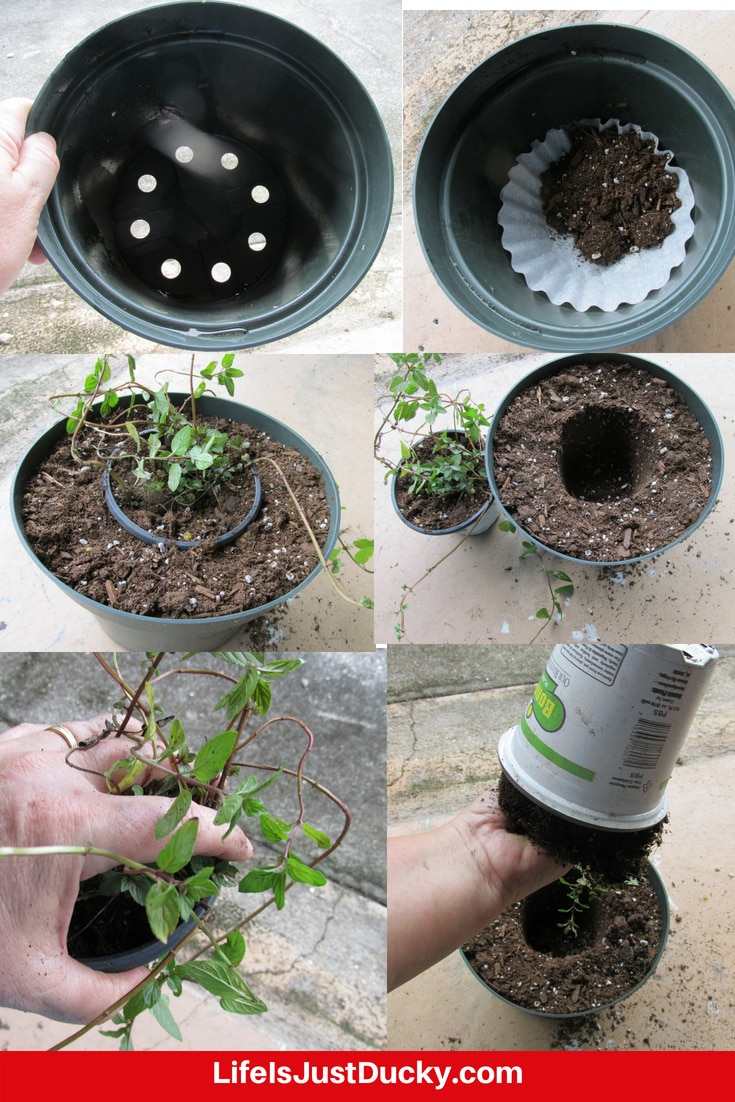Container gardening and I go way back.
If you love to grow vegetables as much as I do, you are always trying to find new ways to slip in a few more plants. I’m not saying it’s an obsession or anything…well maybe. But it’s a good obsession to have.
My first garden was a container garden on a balcony of our apartment building on the 4th floor. Containers allowed me to grow food without owning any land. For many people, container gardening is the only way they can start a garden.

This post may contain affiliate links. Please read my disclosure if you have questions.
Thank you for supporting this site with purchases made through links in this post. Here’s My Amazon Link
Table of Contents
Start Container Gardening Today.
A container garden can be placed anywhere, even the smallest balcony, or patio can support a container or two and you would be surprised at how much abundance that can provide.
This post may contain affiliate links. I will be compensated if you make a purchase after clicking on my links. Please read my disclosure if you have questions.
Thank you for supporting this site with purchases made through links in this post. For Starters Here’s My Amazon Link.
There are a lot of vegetables that will grow fantastically in pots. And many of them are rather pretty so I love having them on my back porch, hanging from the eves of my house, or lining the walk just outside the front door. Even your HOA won’t mind a few pretty pots filled with veggies and herbs with some edible flowers cascading over the side.
If you live in a location where your dirt is terrible, or you have a lot of plant diseases, container gardening could be just the ticket for you to be able to enjoy fresh fruits and vegetables.
One of the beauties of containers is that if the weather decides to turn bad, you can pull your pots inside to protect your plants.
For everyone, container gardening is a great way to grow just a little bit more.
Why Grow In Containers
- No ground to grow in
- Disease in the ground
- Bad Soil
- Saves water
- Can be prettier (HOA approved)
- Sunlight isn’t a problem – move the pot to where the sun is.
- Easier to reach
- Fewer pests
- Less weeding
Related Reading: 12 Easy Vegetables For The Beginning Gardener
What You Need To Start A Container Garden
So aside from the desire to grow your own food (and some really pretty flowers too), what do you need to start container gardening?
-
A plan of what you want to grow and where you can grow it.
-
Containers
-
Soil
-
Hand tools
-
A Watering can or a hose
How to Choose the Right Containers
Though some containers are better than others, any container that will hold soil and has drainage can be used.
You can repurpose old items or buy new. It depends on the look you want and what you want to grow.
One of the best things about starting a garden like this is that you don’t have to use containers specifically designed for planting. Your containers can be virtually anything. If it can hold soil and you can punch a few holes in the bottom for drainage, then you are good to go.
What are some of the types of containers you can use? Standard pots, window boxes, grow bags, buckets, half barrels, railing planters, hanging baskets, gutters, galvanized water troughs, a bathtub, plastic tubs, feed bags, food grade buckets from the grocery store or a restaurant, or your child’s school cafeteria. And these are just a few suggestions.
Related: The Ultimate Beginning Vegetable Gardening Course.
The Right Size For The Right Plant.
One of the most important things to consider when container gardening is to pick the right size pot.
Bigger is usually better. Large plants need a lot of space, and roots need room to grow. The best choice is to avoid small containers as they often dry out too quickly, especially on hot days.
The type of vegetable you’re growing will help decide the size pot you need. For example, tomatoes need a large container. For growing herbs, salad greens, and short carrots, you don’t need as large a pot. 8 inches deep is enough. Window boxes would be a suitable option.
Really large pots are the best choice for bushes and dwarf trees such as blueberries or dwarf apple.
You can use these examples to figure out what vegetables or fruit would be appropriate in which size pot. or you can put several small plants in one large pot.

The Best Type Of Containers
Pots come in many different shapes, sizes, colors, and materials. But which materials and type of pots are best.
- Glazed Ceramic – If you are looking for a beautiful planter, you can’t go wrong with glazed ceramic. They can dress up a front entry in a hurry. But the downside is that they are often quite expensive, and heavy. Make sure they have drainage holes and a saucer is a big plus.
- Plastic – Though not quite as long-lasting, these can look quite nice and come with a much lower price tag. They are usually much lighter and easier to move around. These usually come with drainage holes and saucers.
- Wooden – Some of these can be very beautiful. One type is the half wine barrel which can give a rustic or sophisticated look. The water you add to your plants will tend to rot the wood after a while, so you must consider them a short-term planter. These seldom come with a saucer so you need to consider drainage.
- Metal – Metal can get hot if it is in the direct sunshine, this can cook the roots of your plants.
- Concrete – These are very durable and will last for many years. They can easily be painted and decorated any way you wish. They are, however, very heavy and difficult to move. Make sure they have a drainage hole. For a fun project, many people are making their own concrete planters.
- Terracotta – Though this is one of the most iconic options, in my opinion, it is one of the worst for most situations. Terracotta is very easily broken. But worse yet they wick the water away from the soil and dry your plant out very quickly.
- Strawberry Jar – This type of planter is a great way to grow strawberries, herbs, or other small plants like lettuce. You can add a touch of beauty with a Strawberry Jar.
- Potato Tower – Potato Towers are DIY projects with welded wire filled with hay or grass clippings. They are a wonderful way to grow potatoes or keep your larger plants out of the poor soil or standing water.
- Topsy Turvy Planters – A great way to use vertical space and keep your plants away from 4 legged pests and bad soil is the Topsy Turvy planter.
- Elevated Garden Beds – Raising your garden so you don’t have to bend down is not only pretty, but it can be very practical for someone who is not able to bend down or who might be in a wheelchair. An elevated garden bed
can also be good to keep children’s little feet out of your garden.
- Buckets – Though not a pretty option, buckets can be a very practical option if you are looking for low cost and ease of mobility (it comes with its own handle). Just drill a few holes in the bottom and you are good to go. Look for food grade buckets.
- Grow Bags – Grow bags are a new rage for good reason. You can buy them inexpensively or make your own. At the end of the growing season, empty them and they fold up and use very little space to store. They also come in a variety of sizes.
Related Reading: How To Save Money With Grow Bags.
- Hanging Baskets – A great way to add more plants when you don’t have any more ground space. They can really dress up your place. The big downside is they dry out quickly. Make sure you add some water crystals to your planting mix or a diaper in the bottom to retain moisture.
- Garden Tower – You can grow a whole garden’s worth of plants in a very small footprint with a garden tower.
- Plant Dolly – One option to make your container, whatever type you choose, easier to move is to put it on a plant dolly. Put it on wheels!
The Steps To Plant A Container Garden
Planting and growing in a container is a little bit different than growing in the ground.
Remember this can be a bit messy. If you are doing this outside where you can hose off your work area, great. If not you may want to spread out an old sheet to make cleanup easier.
1. Decide what you want to grow.
- How many pots do you have room for?
- How much time do you want to spend taking care of them?
- And what do you like to eat?
2. Choose Your Pots.
- The material of your containers
- The size you need to grow the type of vegetable or fruit you wish
3. Placement.
- Remember, just as in a garden in the ground, you will need to consider the proper amount of sun for what you’re growing. If your pots will be in a shaded or semi-shaded area, your plant selection will be limited.
- Put your pot where you want it to stay before you add the soil. (Big pots are heavy and hard to move after they are full.)
Related Reading: The Ultimate Garden Tools List For The Backyard Homesteader
4. Cover the holes.
- Yes, I said to make sure your container has drainage holes. If it doesn’t, use a drill and add a few in the bottom. This will ensure your plants don’t drown. Now that your pot has holes, be sure to cover them with a coffee filter or cheesecloth to keep dirt in but allow excess water to flow out.
5. Fill your container.
- Choose a quality soil to fill your containers with. You want it to hold moisture and have plenty of air for the roots to breathe. Do Not Use Soil From Your Yard. (see below for a good potting soil recipe)
- Make sure your soil is moist before you begin.
- If you are planting seeds fill the pot to 1″ from the top. Add your seeds, cover, and gently water in.
6. Planting Seedlings
- If you are planting seedlings fill the pot only half full.
- Don’t take your seedlings out of the pots they came in.
- Start by placing them ON the soil in the pot. Make sure the soil line will be about 1″ below the rim.
- Arrange the seedlings (pot and all) where you want them.
- Fill in with soil around the seedling pot. Carefully remove the seedling pot.
- Turn it upside down with two of your fingers on either side of the stem.
- Using the other hand, lift off the seedling pot. You may need to squeeze the pot a bit, but don’t pull the stem.
- Place the seedling back in the hole it came out of.
- If you have more seedlings, repeat.
- The soil should be at the same level on your seedlings as it was in the old pot.
- Gently water in.
7. Mulch It
- Finally, add a thin layer of mulch across the top of the dirt. This will help the plant to be able to retain moisture.

Soil
The potting soil is a very important part of container gardening! Never use ordinary soil, use potting mixes made for containers or make the potting soil yourself.
Plants in containers need the best possible soil, aeration, and drainage for healthy root growth and optimum harvest. Do not use soil from the garden: It is too heavy, can become waterlogged, and brings disease and insects with it. Choose instead a soilless mix (quick-draining and lightweight) or use compost, combined with a soilless mix.
Here’s a good recipe for “make your own” potting soil.
Mix 1/3 peat moss or coconut coir, 1/3 compost mixture (worms make the BEST compost), and 1/6 vermiculite 1/6 perlite. This mix preserves moisture and lets roots breathe which is very important for container gardening.
Related Reading: Microgreens – How To Grow Them – The Beginners Guide.
Watering
When I was a child, my mom and I went to visit relatives for three weeks. Mom left dad a note. (he had to stay home and work) It said, among other things, to remember to water her plants. He read it every day, sometimes several times a day. When mom got back she poured the water off from her now dead plants.
- Don’t over-water your plants
Container gardening can be a bit tricky. If you water them too much they’ll die from the roots not getting enough air and then the roots will rot. (Like my moms did)
To avoid over-watering your plants, make sure to use containers that have drainage holes.
Water only when the top 1 inch surface of the soil feels dry.
- Don’t under-water your plants
Lonely husbands aside, most people are more likely to under-water their container plants.
- Make sure where you put your containers is conveniently close to a water source.
- In-ground gardens don’t have to be watered as frequently as container gardens due to the sheer volume of soil in an in-ground garden and how far the roots can spread looking for water.
- Check on the soil in your containers regularly. You may have to water every day or two, even more often in very hot weather. Don’t let them dry completely out!
- When you water, make sure to really soak your plants. If you only give them a tiny bit, the water will only wet the top layer of soil. which won’t reach the roots. I like to water until I can see it coming out the bottom of the pot.
- Drip system – An easy way to make sure you don’t forget to water your containers is to install a drip system with a timer.
Related Reading: Throw A Compost Tea Party For Your Plants

Additional Tips For Container Gardening
- Don’t fill a big container in the wrong place or you won’t be able to move it.
- Know what your particular plants like. More or less water, full or partial sun, is it sensitive to cold or hot temperatures?
- Don’t forget to fertilize. Compost tea and fish emulsion are great organic choices.
- Avoid applying too much nitrogen to fruiting vegetables such as tomatoes and peppers.
- Keep an eye out for pests, always check the underside of leaves to find bugs.
- Don’t forget to use plant markers so you remember what you have planted.
-
Be sure the size of your container is appropriate for the size of your plant.
- Slip in a few edible flowers for beauty and to attract pollinators.
-
Be sure to make arrangements for your plants when you go on vacation. And give the plant sitter proper instructions.




